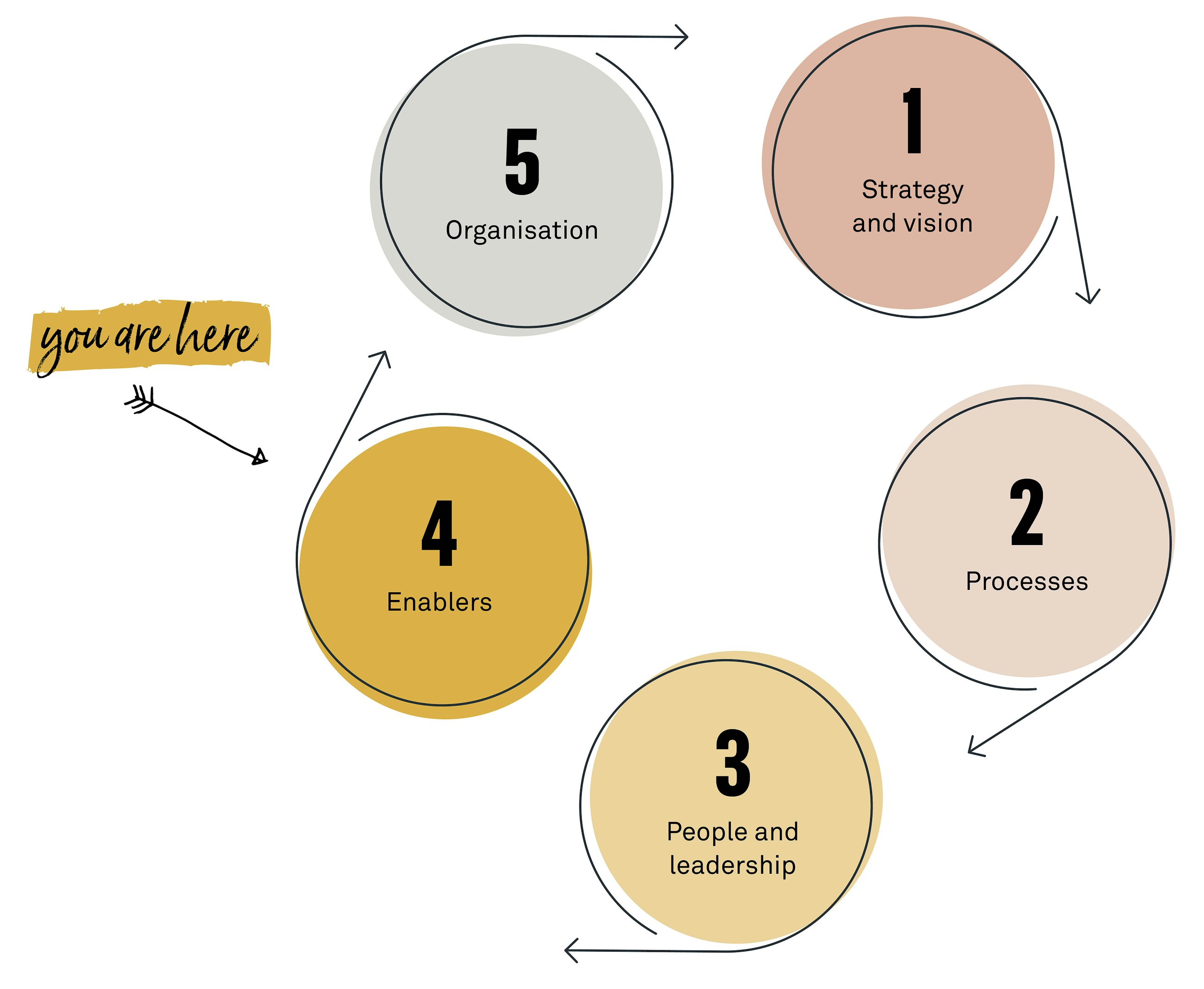– to support, unify and accelerate your agile transformation
8 July 2021
An agile transformation typically touches upon all aspects of an organisation: how teams are organised, how strategy is formulated and executed upon, how teams collaborate on a daily basis, and which processes enable collaboration across the organisation. Therefore, the journey towards organisational agility often also needs to be accompanied by a change in some of the more foundational aspects of an organisation. The topic of attention in this article is the enablers. These refer to the elements or mechanisms that support, unify or accelerate your agile transformation.
In this article, we explore two categories of enablers:
- IT enablers which support the agile operating model.
- The physical and virtual workspace that enables teams to foster creativity, productivity and flow.
We explore how organisations should handle key enablers and ensure that they are designed and developed to fit the organisational operating model as well as the new culture that is implemented.
At Implement, we have years of experience with implementing new behaviour in organisations. Based on this experience, we have developed a model to support businesses on their journey towards organisational agility. The model consists of five activity tracks that will help you structure your journey towards organisational agility.
This is the fifth article in the series. If you are interested in reading the other articles, you can find them below:
Articles in the series0 4
Agile transformation – Establishing a powerful, soulful and meaningful organisation for your employees
We have developed a model to support businesses in their journey towards organisational agility. The model consists of f...IT enablers
On the journey towards organisational agility, many companies will be faced with choices regarding technology and might find themselves having to answer questions such as: Should teams work in Jira or MS Teams? Do we need a new resource planning tool? Can we collaborate in Miro? The answers to these questions are essential, as the tools help power the organisation and the new agile ways of working by acting as the glue that ties planning and collaboration together.
However, when looking beyond questions related to enabling tools, few companies consider the full impact of IT in their agile transformations – even when transforming in an IT development unit. This presents a challenge, as underestimating the impact of IT can mean that the realisation of the benefits of the agile transformation will be hindered by IT barriers.
To overcome this challenge, we present 3 key design criteria which we recommend companies to think through to be able to excel in the IT aspect of the agile transformation – especially when doing an agile transformation within IT development.
1. Allow for frequent launches
2. Consider your DevOps strategy
3. Enhance and decouple business services
Allow for frequent launches
At the core of the agile organisation is the idea that by organising around customer value streams, we can limit handovers, allow for faster learning and shorten time to market. As part of the journey towards organisational agility, companies often devote significant time and resources to understand exactly what the customer journeys look like and how to optimise and organise around them. Similarly, companies should inspect their engineering/developer journeys to understand if they are efficient and allow for frequent releases.
If developers spend days waiting for infrastructure services, or if systems and IT governance processes hold up releases, productivity and agility will be hindered. To overcome this, companies should start out by mapping key developer journeys and inspect whether the right processes and tools are in place to allow for frequent releases and whether the delivery pipeline and environment support the developer flow.
Acceleration of developer journeys can happen by optimising collaboration tools (Atlassian, MS Teams, Miro), standardising CI/CD Pipeline, automating infrastructure service requests and ensuring self-service, where possible. The goal of this work is to ease the daily work and free up time that is otherwise wasted for the developers and ultimately limit time from code committed to code in production, thereby enabling shorter time to market.
Consider your DevOps strategy
Efficient agile teams have end-to-end ownership and accountability for their tasks. The same guiding principles should be applied to your developer teams, meaning that companies should look to implement DevOps best practices. By ensuring that workflows incorporate security and operations aspects into every step of the development process, handovers are eliminated and speed in delivery achieved. Teams should be equipped with the skills and mandate to develop and maintain their own products, and control and governance should be implemented in the development tools and process.
Implementing DevOps as more than a set of principles but rather as the operating model is a complex move, as it requires involvement of several functions: Operations, IT Security, Legal, Development, CTO etc. We recommend starting out with setting a Dev(Sec)Ops ambition and concretising the target state across these different units. Also working with lighthouses and starting up with DevOps in 1-2 areas has proven to be a good path forward in a number of companies.
Enhance and decouple business services
Over time, most large organisations have become complex in their architecture landscape due to quick fixes, budget constraints, siloed projects and sub-optimal solutions. This spaghetti architecture limits flexibility and makes it difficult to respond quickly to changes in the marketplace. To be able to react quickly to customer pain points or market opportunities, you need an architecture that allows you to act, develop, test and release at a high pace. To do this, decoupling your architecture, or in some cases rebuilding it, is required.
To support an agile organisation in achieving actual autonomous teams, you need to focus on domain-driven design and decoupling through strategic reusable APIs. As a first step, identify customer journeys and analyse existing architecture pain points and gaps to understand which domains are relevant to modularise. Modularisation of the architecture makes it possible for single blocks of architecture to be optimised or changed in insolation without risk of dependencies of each integration. Decoupling business services overnight is not possible; and for most large-scale companies, it is a long-term ambition, but identifying your target architecture and ensuring a fit to the new agile organisational structure and target customer journeys will be a key first step.
Workspace enablers
A significant body of research points to the fact that the work environment (defined as material spaces and objects) affects not only employee well-being but also job performance and job satisfaction. Some even point to the conclusion that the working environment comprises as much as 30% of the overall employee experience (Morgan, 2017). Working in an inspiring and well-designed environment will spark employee creativity and engagement and help create a stronger connection to daily tasks and the organisation.
In an agile context, the workspace must support collaboration, flow, agile ceremonies and the organisation around small teams, network and customer focus. Previously, co-location was a key driver of most agile teams. However, if 2020 has taught us anything, it is that flow and teamwork are absolutely doable virtually too – if you have the right tools in place. Going forward, we believe that the workspace can be either physical or virtual, as long as your overall objective is to create a workspace that enables collaboration and flow. The design criteria presented below will guide you to how to design a workspace that supports, unifies and accelerates your agile transformation.
1. A workspace that supports transparency
2. A workspace that provides all team members with a shared overview
3. A workspace that supports well-functioning ceremonies
A workspace that supports transparency
Agile teams typically work on tasks that require multidisciplinary input and which are characterised by a high degree of interdependencies between team members. To ensure that tasks are carried out efficiently and that team members have clarity about ongoing activities, workspaces should be designed with transparency at heart. Transparency of ongoing activities will help increase team productivity, create visibility of potential bottlenecks, ease communication and will additionally foster a sense of openness and trust within the team – a cornerstone of agile organisations.
Transparency can be created by means of physical objects such as Kanban or Scrum boards or dedicated wall spaces for sticky notes. Similarly, virtual tools such as Jira or Teams Tasks can help structure and track ongoing activities in a virtual setting. Transparency can be further increased by striving to make daily tasks as visual as possible to enhance commitment, alignment and mutual understanding between team members. Visuals may take the form of prototypes, images and tools that provide a quick overview of task complexity.
When considering the transparency aspect, the objective should be to design workspaces (physical or virtual) that provide the entire team with the same overview of tasks and invite them to participate actively in the process of maintaining transparency.
A workspace that provides all team members with a shared overview
Agile ways of working support the ambition of balancing autonomy with alignment: a high degree of autonomy is anchored in the individual teams to enable fast decision-making, prioritisation and progress. At the same time, however, agile organisations also need to be highly aligned on a shared vision, fixed heartbeat and critical processes.
To succeed in this balancing act, organisations should strive to create workspaces that provide teams with a shared overview. This includes visualising the shared ambition and goals, the latest update on team OKRs and KPIs, an overview of upcoming initiatives, epics or tasks and a clear overview of why the backlog has these priorities. This can either be done physically on a team wall or virtually in tools such as Miro or in dedicated team dashboards.
By creating a shared overview of which indicators, metrics and goals the team is striving to optimise, organisations will help build a sense of team commitment and ownership and guide ongoing prioritisation of tasks. We recommend that the whole organisation uses the same system or platform to create a shared overview of tasks to ensure a shared picture of priorities and progress.
A workspace that supports well-functioning ceremonies
Agile organisations are anchored around a fixed organisational heartbeat, which means that all teams follow a fixed cadence for their weekly, monthly and quarterly ceremonies. (In agile terms, ceremonies refer to specific meetings with a fixed agenda and frequency). When designing agile workspaces, organisations should strive to make them flexible to support facilitation of different ceremonies, tasks and types of work. This can be done by creating open rooms for brainstorming and collaboration and focused rooms for breakout sessions which require attention to detail-oriented tasks.
The same flexible set-up should be created virtually with collaboration tools such as MS Teams, Miro or Zoom and by ensuring a stable internet connection which can support audio and video meetings. In our experience, facilitation of large-scale events such as quarterly planning with >100 people can be easily facilitated online as long as the right tools and structures are in place.
We recommend delegating spaces for teams to sit together physically (e.g. with boards, values etc.) designed for them to work together. Furthermore, the general workspace must encourage openness, creativity and flexibility to drive and visualise the creative identity which an agile organisation should have. An example of this is opening up the offices, putting up whiteboards and glass walls to write on, design cosy sofa corners, install funky art etc.
Designing and implementing the right enablers
The enabling mechanisms and tools you decide for your agile transformation will support and accelerate organisational and process changes and will ultimately help unleash the full potential of agile principles, ways of working and structures. The design principles presented above provide you with a way to structure your approach to enablers. However, design and implementation of specific enablers will surely depend on your starting point and objectives for the overall agile transformation. Defining your ambition and agreeing on the target state will be beneficial and help you get started.
References
Denning, S. (2018). The Age of Agile. New York: AMACOM.
Half Double Institute (2020). Half Double Compendium V 04. Hellerup: Half Double Institute.
Lange, F. (2021, May). THE IMPORTANCE OF PROCESSES in the journey towards organisational agility.
Morgan, J. (2017). Employee Experience Advantage. New Jersey: Wiley & Sons.










